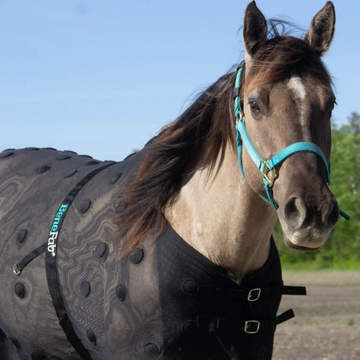
Most injections are given by a veterinarian; however, there are some instances when horse owners are responsible for giving an injection. Safely administering an injection is extremely important for your horse. An intramuscular injection (IM) is the most common type of injection given to horses. IM injections are given deep into a large muscle mass. There are four main injections sites used when giving an IM injection. These sites are chosen because there is no danger of hitting a bone, ligament, nerve, or blood vessel. Intramuscular injection sites also promote drug absorption and decrease the chance of swelling and pain at the injection site.
- Base of the neck – This is the most favored injection site for horse handles. It is easy to administer the drug from this location and the administrator is relatively safe as they are located by the horse’s shoulder. The easiest way to locate an appropriate injection site is to place the heel of your hand at the base of the horse’s neck where his neck joins his shoulder. The area that is covered by your palm is site where the injection should be done.
- Pectoral muscles – The pectoral muscles are located in the chest of a horse. This site is a little risky for the administrator because they must place themselves in the front of the horse to see the site clearly. The pectoral site is generally only used when the horse has received previous injections and those sites are sore. However, this site drains very well. The injection site is the bunchy muscles that are located on the lower half of the chest between the tops of the forelegs
- Buttocks – The buttocks is a good injection site because this muscle is used every time the horse takes a step. This forces the horse to use this muscle instead of “babying” it. The biggest drawback to this site is the risk of the administrator. The administrator is located in the kick range when giving this injection. The injection site is found by locating the bony protrusion on the horse’s hip. Once this site is located, drop about one inch lower and inject anywhere in the muscle mass along the back of the leg.
- Top of the rump – The top of the rump is another very common injection site. The biggest drawback to this site is the poor drainage associated with a needle abscess. If an infection occurs, it is not easily treated. However, this site keeps the administrator relatively safe while giving the injection. This injection should be given on the intersection line of the tail head and point of hip and the top of croup and point of buttocks.
When giving an IM injection, you must consider your experience, the injection site, and the horse’s attitude towards injections. Some horses may be afraid of needles. If this is the case, you may want someone more experienced to administer the injection. Get your vet’s approval before any injections are given.
For more information on IM injections, visit:
http://www.extension.org/pages/29835/how-to-give-your-horse-an-intramuscular-injection#.VK9IQmRDtgo
 Most injections are given by a veterinarian; however, there are some instances when horse owners are responsible for giving an injection. Safely administering an injection is extremely important for your horse. An intramuscular injection (IM) is the most common type of injection given to horses. IM injections are given deep into a large muscle mass. There are four main injections sites used when giving an IM injection. These sites are chosen because there is no danger of hitting a bone, ligament, nerve, or blood vessel. Intramuscular injection sites also promote drug absorption and decrease the chance of swelling and pain at the injection site.
Most injections are given by a veterinarian; however, there are some instances when horse owners are responsible for giving an injection. Safely administering an injection is extremely important for your horse. An intramuscular injection (IM) is the most common type of injection given to horses. IM injections are given deep into a large muscle mass. There are four main injections sites used when giving an IM injection. These sites are chosen because there is no danger of hitting a bone, ligament, nerve, or blood vessel. Intramuscular injection sites also promote drug absorption and decrease the chance of swelling and pain at the injection site.






















